CarEdge saved me over 4,500 dollars on a brand new Honda Pilot. I can't say thank you enough.
Price intelligence
Find a wide range of vehicle listings with market insights on new and used listings near you.


Help us personalize your CarEdge experience — it only takes a second.
Your answers help us personalize your CarEdge journey — we’ll follow up with tips and next steps that match your buying timeline.
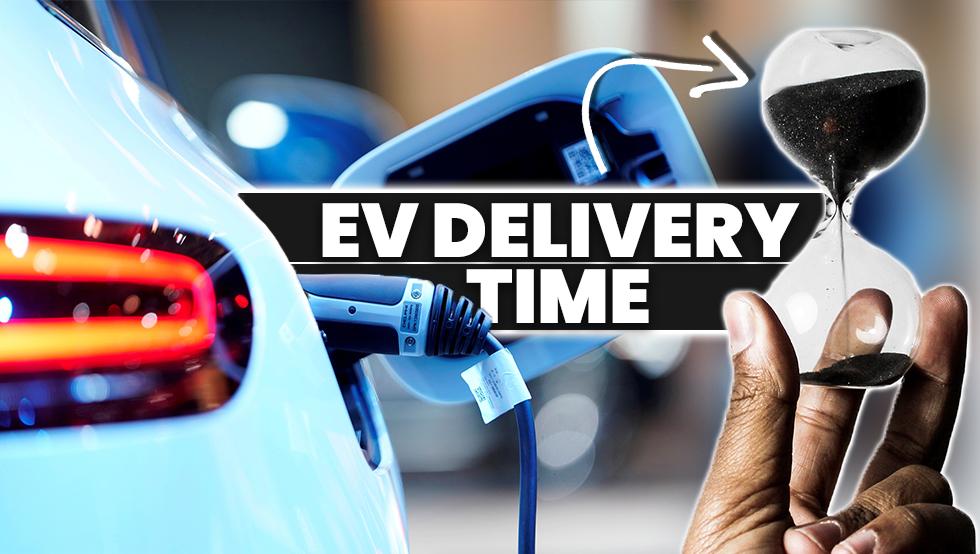
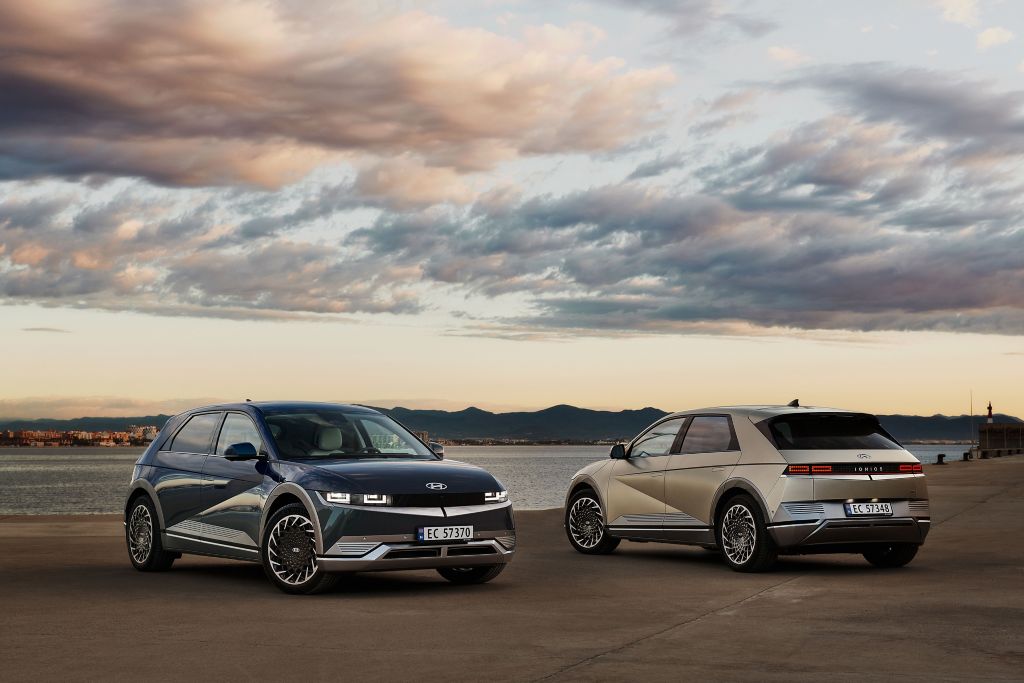
(Updated for Summer 2022)
As anyone who’s fallen head over heels for one of the many 2022 electric vehicles and clicked that ‘Order’ button can attest, just because you can order an EV in 2022 doesn’t mean you can drive it home this year. This was a problem I faced myself, but I finally broke the code and got a Hyundai IONIQ 5 at MSRP (here’s how).
Soon after I began my online car search, it became clear that if I wanted a brand-new vehicle, my options were limited by availability. To make the most of the situation, I thought I’d share what I’ve learned about the availability and estimated delivery times for EVs on the market today. Here’s what we know as we kick off the new year.
Note: These are fully-electric models that can either be ordered now or purchased at a dealership today. Many more have been announced but are not yet officially available.
| Make | Model | Class | Starting MSRP | Estimated Delivery/Lot Availability* |
|---|---|---|---|---|
| Audi | e-tron | crossover SUV | $65,900 | Available Now |
| Audi | Q4 e-tron | crossover SUV | $43,900 | Available Now |
| Audi | RS e-tron GT | sedan | $103,445 | Available Now |
| BMW | iX | SUV | $88,050 | Mid-2022 |
| BMW | i4 | sedan | $55,400 | Mid-2022 |
| Cadillac | Lyriq | SUV | $62,990 | Late-2022 |
| Chevrolet | Bolt | hatchback | $31,000 | Available Now |
| Chevrolet | Bolt EUV | crossover SUV | $33,500 | Available Now |
| Fisker | Ocean | crossover SUV | $37,499 | 2023 |
| Ford | Mustang Mach-E | crossover SUV | $43,895 | Available Now |
| Ford | F-150 Lightning | truck | $39,974 | 2023-2024 |
| GMC | Hummer EV | truck | $99,995 | Mid-to-late 2022 |
| Hyundai | IONIQ | crossover SUV | $33,245 | Available Now (Discontinued) |
| Hyundai | IONIQ 5 | crossover SUV | $43,650 | Available Now |
| Hyundai | Kona | crossover SUV | $34,000 | Available Now |
| Jaguar | I-Pace | crossover SUV | $69,900 | Available Now |
| Kia | Niro | crossover SUV | $39,990 | Available Now |
| Kia | EV6 | crossover SUV | $42,115 | Available Now |
| Lucid | Air | sedan | $77,400 | Mid-2022 |
| Mazda | MX-30 | crossover SUV | $33,470 | 2022 - CA Only |
| Mercedes | EQS | sedan | $102,310 | Available Now |
| Mercedes | EQB | SUV | ~$55,000 | Late 2022 |
| Nissan | Leaf | hatchback | $27,400 | Available Now |
| Nissan | Ariya | crossover SUV | $47,125 | Late 2022 |
| Polestar | Polestar 2 | sedan | $45,900 | Available Now |
| Porsche | Taycan | sedan | $82,700 | Available Now |
| Rivian | R1T | truck | $67,500 | 2023 |
| Rivian | R1S | SUV | $70,000 | 2023 |
| Subaru | Solterra | crossover SUV | $46,220 | Mid-to-late 2022 |
| Tesla | Model S | sedan | $94,990 | Late 2022 - 2023 |
| Tesla | Model 3 | sedan | $46,990 | Mid-to-late 2022 |
| Tesla | Model X | SUV | $104,990 | 2023 |
| Tesla | Model Y | crossover SUV | $62,990 | Late 2022 - 2023 |
| Toyota | bZ4X | crossover SUV | $43,215 | Mid-to-late 2022 |
| Volkswagen | ID.4 | crossover SUV | $40,760 | Mid-2022 |
| Volvo | XC40 Recharge | crossover SUV | $55,300 | Available Now |
| *For a vehicle ordered in May 2022, unless there's existing dealership supply. |
A few things might stand out to you on this list. Not a lot of options are available if you need a new vehicle right now. VW Group’s new EVs are available at many dealerships, although there are reports of major dealer markups. It’s quite easy to find EVs of the previous generation on dealer lots. Think Kia eNiro, Hyundai Kona EV, Nissan Leaf and the like.
The vast majority of 2022 electric vehicles are crossovers. No surprise there given the sales trends over the past decade. Honda doesn’t have a single EV arriving in the North American market until the 2024 Prologue electric SUV. That is surprising considering the popularity and good reputation of the brand. What will it take for automakers to catch up to demand? An end to the chip shortage would be a great step in the right direction. There’s also the supply versus demand factor. Ford, Rivian, Tesla and VW are all swamped with orders well into 2022, and even into 2023. All except Tesla are EV newcomers who are facing the same production ramp-up struggles that Tesla just barely survived a few years ago. We’ll update this page regularly as more information becomes available, so save it to your bookmarks!
Did we miss anything? Let us know in the comments below, or shoot an email to [email protected].


As if anyone needed one more reason to be anxious, some of today’s electric vehicles have inspired a new kind of dread: range anxiety. If you’re new to the world of EVs, you may be wondering why electric vehicle range figures are compared and analyzed meticulously. Maybe you’re even skeptical of EVs because of the sub-300 mile ranges touted as the latest and greatest. The largest automakers are committed to electrification, and American drivers are finding that shopping for an EV is a different experience. There’s no doubt it takes some getting used to. Is the instant acceleration and cheaper fuel worth the learning curve that comes with EV adoption?
Electric vehicle charging stations are still few and far between in most of America. Even charging technologies vary widely from one vehicle to the next. A few new EVs are behind the times when it comes to charging speed, most notably the Chevy Bolt. Others, like the Hyundai IONIQ 5 and Porsche Taycan, are progressing forward with the fastest top-up times in the industry. Thankfully, charging an EV in America is about to get a lot easier in 2022. Billions of dollars in both private and public funding is being funneled into growing the nation’s public charging infrastructure over the next two years. EV range figures will likely become less defining for each new EV that hits the market as charging becomes quicker and easier to find.
As we enter 2022, range is still top of mind for consumers. But estimating EV range is not an exact science. Some vehicles regularly exceed EPA mileage ratings, but many others fall short of the advertised figures. Here’s what consumers need to know about real-world range in today’s growing EV market.

Speed is the number one factor that determines electric vehicle range. The relationship between city/highway driving and range is the opposite with an EV than you’ll find with a combustion-powered vehicle. With a traditional combustion vehicle, better gas mileage is achieved at highway speeds, usually between 50-70 miles per hour. That’s not so with EVs.
EVs are more efficient at lower speeds, even in stop-and-go traffic. Let’s consider the example of the best-selling Tesla Model Y. The 2022 Model Y’s combined range rating is 330 miles, or 125 mpg equivalent. A closer look at the city and highway figures tells an interesting story. On the highway, the US EPA calculates the Model Y’s fuel economy as 131 mpge. Real-world testing at 70 mph finds that the Model Y can make it about 275 miles on a charge. However, in city driving scenarios at lower speeds, the Model Y is good for an astounding 131 mpge, or over 350 miles of range. The story is the same for most other EVs: slower driving around town yields greater efficiency and more range.
Why is speed such an important factor for electric vehicle range? It all comes down to something engineers can’t control, only accommodate: physics. At higher speeds, a vehicle encounters higher friction as it pushes through the air. Friction causes drag, and drag can only be overcome by more force. In this case, the additional force is supplied by higher power output from the electric motors. This is why EV stats often include the ‘drag coefficient’ along with horsepower, torque, curb weight and the rest of the usual metrics for comparison.
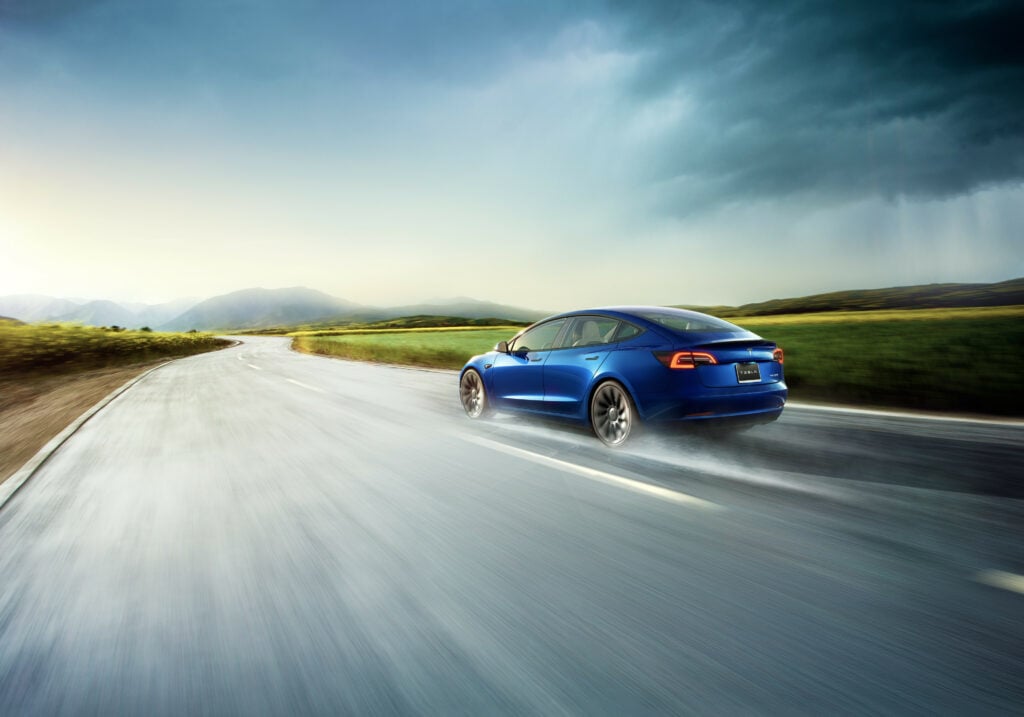
Temperature, wind and even precipitation can all affect electric vehicle range, especially at higher speeds. Every battery-electric motor platform has an ideal operating temperature. Usually, the ideal temperature is somewhere near 70 degrees Fahrenheit. At the ideal temperature, the vehicle can attain up to 115% of its official rated range. That means a Ford Mustang Mach-E rated for 270 miles may actually make it over 300 miles on a single charge in perfect conditions.
Summer heat eats into range somewhat, but winter cold is the real range killer. Effects vary from one model to another, but it’s not uncommon for an EV to lose 30% of its range in freezing temperatures. Why? The cold itself is responsible for about 10% of the range loss, but it’s actually running the heater that demands so much energy, and range takes an even bigger hit. Winter weather is so problematic for EVs that many OEMs are installing heat pumps in their latest models in an effort to reduce range loss in the cold.
As long-haul truck drivers know well, a headwind or severe crosswind kills range for all vehicles, regardless of fuel type. An EV normally rated for 250 highway miles might not even make it 200 with a strong headwind. On the other hand, a tailwind can extend range far beyond the usual performance. Once again, this is similar to what drivers of combustion vehicles will experience.
Rain and snow also reduce range by adding to drag. Think of it this way: any vehicle, electric or otherwise, uses more fuel to literally push through the air as precipitation falls onto it.
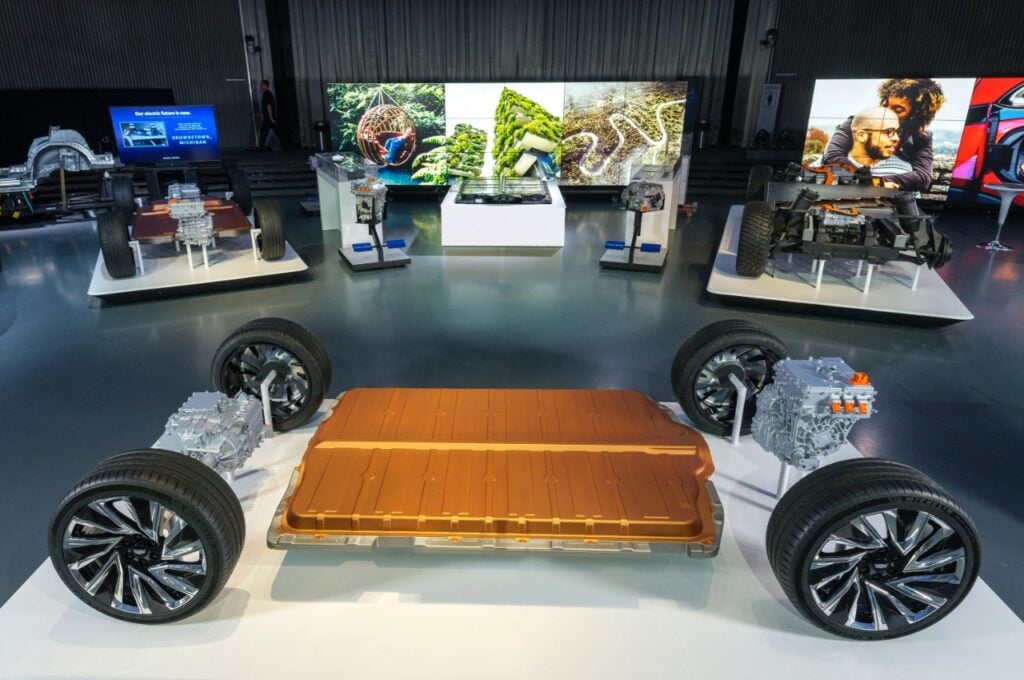
All EVs lose rated range as they accumulate miles on the odometer. It’s just a part of battery wear and tear. The range loss is greatest as the vehicle is ‘broken in’ so to speak. Tesla vehicles lose about 5% of their range within the first 30,000 miles of driving, but range loss slows down afterward. There are many examples of Teslas with 200,000 miles on the odometer that continue to carry 90% of the original range, and almost all retain at least 85% by this point. Other EVs show similar range loss over time.
Battery degradation is unavoidable, but there are measures that EV drivers can take to minimize it. Limiting level 3 fast charging to only when necessary (such as road trips) is the biggest effort anyone can make to preserve the health of their battery. Charging at home on a level 1 or 2 charger to 80% or 90% state of charge is recommended for most EVs. Only when the extra mileage is needed should EVs be fully charged to 100%. One notable exception is the 2022 Tesla Model 3. Tesla has decided to put lithium-iron-phosphate (LFP) batteries in the standard range variants of the Model 3, making this the first EV on the market to withstand regular charging to 100% without notable battery degradation. Perhaps this was a factor in Hertz’s recent decision to buy 100,000 Model 3’s.
With so many factors going into EV range, you might be wondering how one can reliably estimate the range of their EV in real time. Luckily, engineers saw the need for real-time range estimators and got ahead of this challenge. Today’s EVs include smart range estimators (that some affectionately call guess-o-meters) that factor in a number of variables to display the remaining range for the driver. Real-world range figures don’t necessarily make road trips challenging, but for the time being, it is something else for drivers to monitor while charging stations remain uncommon.
Curious as to how your favorite electric vehicles match up in real-world range? The EV experts over at InsideEVs have compiled a database of how every model they’ve tested firsthand performs in the real world. Some EV models far exceed their official EPA ratings, while others come up short. Below are a few of their more notable findings.
Source: InsideEVs

Today’s EVs are expected to retain 85-90% of their original range after 100,000 miles, and possibly even over 200,000 miles. This normal range loss is due to battery wear after repeated charging and discharging cycles. Real world range is something for EV shoppers to bear in mind when comparing models. Remember: If an EV is EPA rated for 250 miles, it will likely only achieve 225 miles on a full charge after 100,000 miles of driving.
The data from InsideEVs shows that some automakers consistently underperform their ratings, while others exceed expectations. Will range anxiety turn buyers away, or will tech and sporty handling compel more drivers to think about going electric? Let us know your thoughts in the comments below. We’ll continue to keep you informed as electrification overtakes the auto industry.
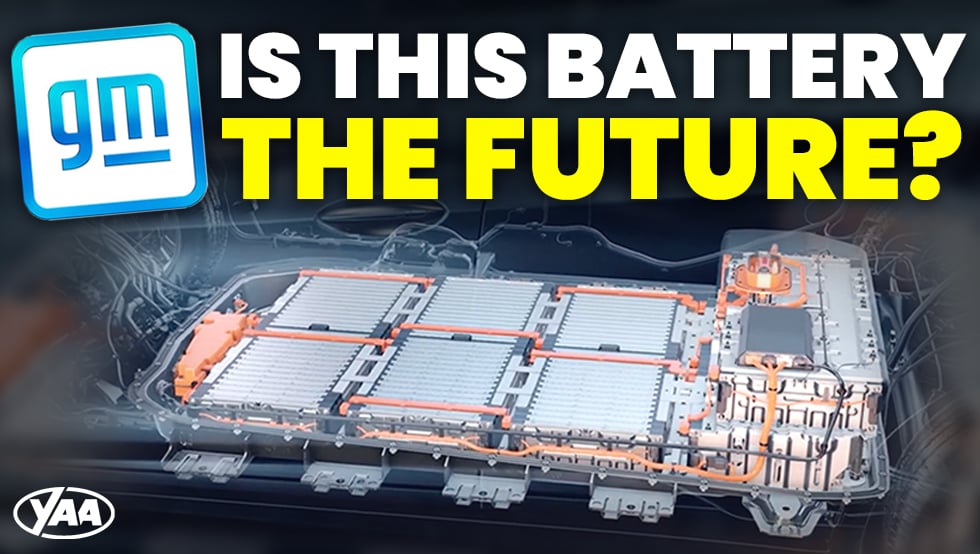

When GM launched its first plug-in hybrid in 2010, the Chevrolet Volt, turning a profit was an uphill climb. It was a time when EVs were a pipedream to most OEMs. Nissan was nearing the launch of the Leaf, the first fully-electric mainstream vehicle ever. Tesla was a nascent startup raising funds by selling the first-generation Roadster. Automakers old and new alike knew that if EVs were to ever become affordable for the masses and profitable for OEMs, the costs of battery production would have to plummet, and battery efficiency and durability would have to increase.
Here we are 12 years later, and GM is ready to launch its first vehicles powered by their all-new Ultium battery platform and propulsion system. Is the platform a technological leap forward? Could it be the key to dethroning Tesla, or is GM after something different altogether? Here’s the latest on what GM claims is the game-changer for mass electrification.
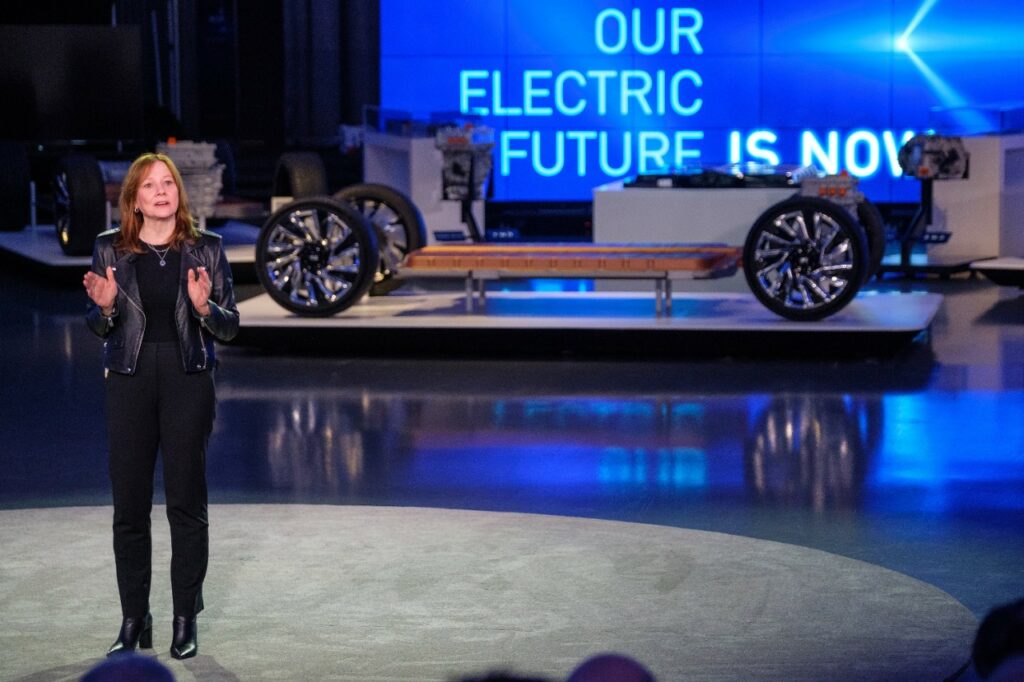
When GM CEO and chairman Mary Barra announced the Ultium platform in March of 2020, there was a lot going on in the world that overshadowed the gravity of her announcement. However, the automotive industry noticed GM’s confidence in its ability to overcome one of the biggest barriers to affordable EVs: battery production costs. Battery capacity is most often measured in kilowatt-hours (kWh). For reference, a plug-in hybrid like the 2011 Chevrolet Volt has a smaller battery, 16 kWh in this case. Today’s popular EVs like the Tesla Model Y, Ford Mustang Mach-E and Volkswagen ID.4 have battery capacities in the 70-80 kWh range.
At the time of the Volt’s launch in 2010, battery costs were about $1,000 per kWh. That meant that the Volt’s 16 kWh battery was the most expensive component of the car. Now, Mary Barra says that the new Ultium platform will be produced at less than $100 per kWh. To date, only Tesla has been known to have reached such battery affordability, and it’s been considered a key ingredient in their secret sauce for success. The press release announcing Ultium didn’t beat around the bush, stating that “the first generation of GM’s future EV program will be profitable.”
Plenty of automakers have ambitious, expensive plans for electric vehicles, but if GM is already there in 2022, are we witnessing a major disruption to the EV segment in real time?
They’re not going it alone. In fact, all major OEMs partner with battery producers to produce their EVs, from Tesla to Ford. In this case, GM is continuing to work with LG Chem for Ultium development and production (which has already begun). LG Chem is a respected battery supplier for Stellantis, Lucid and even some Teslas.
What could go wrong? You’ve heard about the Chevy Bolt battery fires that have resulted in recalls, stop-sales and $2 billion in expenses for GM? LG Chem supplied those batteries too. LG recently agreed to cover the massive costs of the Bolt recall, perhaps in a last-ditch effort to preserve the business partnership between the two.
The automotive industry usually welcomes second chances (remember the Great Recession bankruptcies, VW’s Dieselgate, etc.?), so let’s hope LG and GM’s partnership results in a great electric platform, one that’s far less flammable this time around.

GM says its all-new global platform is flexible enough to build a wide range of trucks, SUVs, crossovers, cars and commercial vehicles all with the same Ultium architecture. They call it a one-size-fits-all approach to electrifying all GM brands by 2035. At the heart of the Ultium platform is a pouch-type of battery module. This is where scalability becomes easy, at least in the eyes of GM’s engineers. Ford and GM are among the legacy automakers who continue to develop pouch-type battery modules, while relative newcomers like Tesla, Lucid and Rivian are using cylindrical batteries in their vehicles. It will be interesting to see which form factor becomes the dominant battery architecture over the coming years.
The new Ultium battery from GM uses a state-of-the-art Nickel Cobalt Manganese Aluminum (NCMA) chemistry, which was designed to reduce the cobalt content in our batteries by more than 70 percent. Cobalt mining in Africa is notorious for human rights abuses, so the battery industry as a whole is looking to reduce reliance on the element.
In the announcement for the new Ultium platform, GM didn’t hide the fact that they see battery production as a new source of revenue. Vertical integration of most vehicle components has been one of Tesla’s most influential strategies in the auto industry. Now GM leadership sees the value of cutting out the middleman (to an extent). “By vertically integrating the manufacture of battery cells, the company can reach beyond its own fleet and license technology to others,” reads the March 2020 announcement. They also tout their ability to leverage existing facilities and equipment for Ultium battery production.
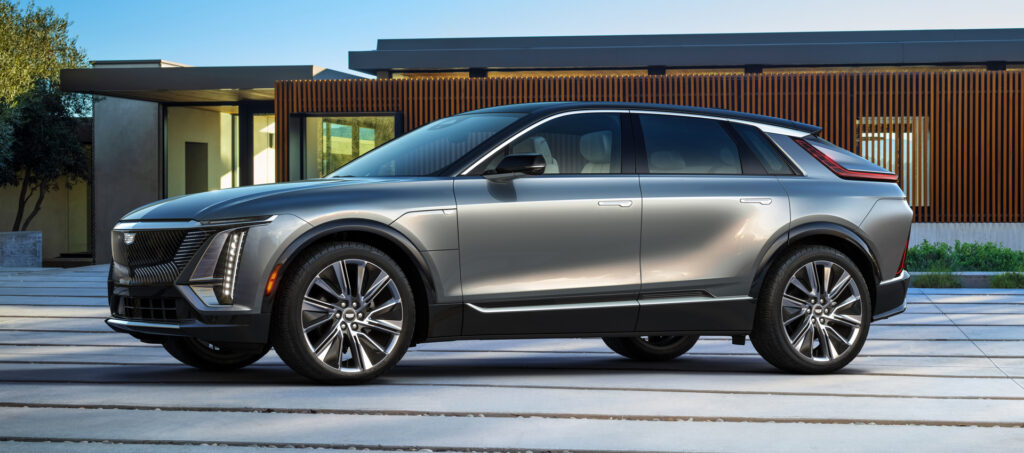
The first generation of Ultium-powered vehicles is already arriving at dealerships. GM just shared the first customer deliveries of the resurrected GMC Hummer EV, a 1,000 hp crab-walking luxury electric truck. In case you’re keeping track, both Rivian and GM have delivered the first electric trucks in America before Tesla has started production of its Cybertruck.

Soon to follow will be the 2023 Cadillac Lyriq electric crossover (starting MSRP of $60,000), which will hit the road in 2022. The real test of the Ultium platform’s market strength will be the Chevy Silverado EV. Electrifying one of GM’s best-sellers is a bold move. We don’t know much about the electric Silverado yet, but GM will unveil the truck on January 6, 2022 at the CES expo in Las Vegas.
GM plans to stop selling combustion vehicles by 2035, so a LOT more Ultium vehicles are surely in the making. Cadillac will be exclusively electric by 2030, a mere eight years ahead. What’s next, an electric Camaro?
Execution is key for GM. We learned in 2008 that no automaker is too big to fail, and a Bolt-like battery blunder can’t happen with the new Ultium platform. Hopefully GM and partner LG Chem have taken the time and due diligence to get it right. It remains to be seen if GM will price its vehicles competitively.
The 2022 Chevy Bolt and Hummer EV are worlds apart in terms of affordability. In fact, the Bolt and Nissan Leaf are the only two popular EVs that typically sell for under $40,000. Will EVs forever be mostly $40k-plus models, or will American soon have Ultium-powered economy options to consider. Only time will tell if consumers are willing to spend Tesla money on a GM EV in 2022. About 641,000 employees work for the big three American automakers (GM, Ford, FCA/Stellantis). With so much money, investment and infrastructure on the line, we sure wish for their success.
We have thousands of EVs (and other vehicles) listed today. Each listing includes industry insights, empowering data and the true TotalPrice that will make buying a car the transparent process it should’ve always been. Check it out here!

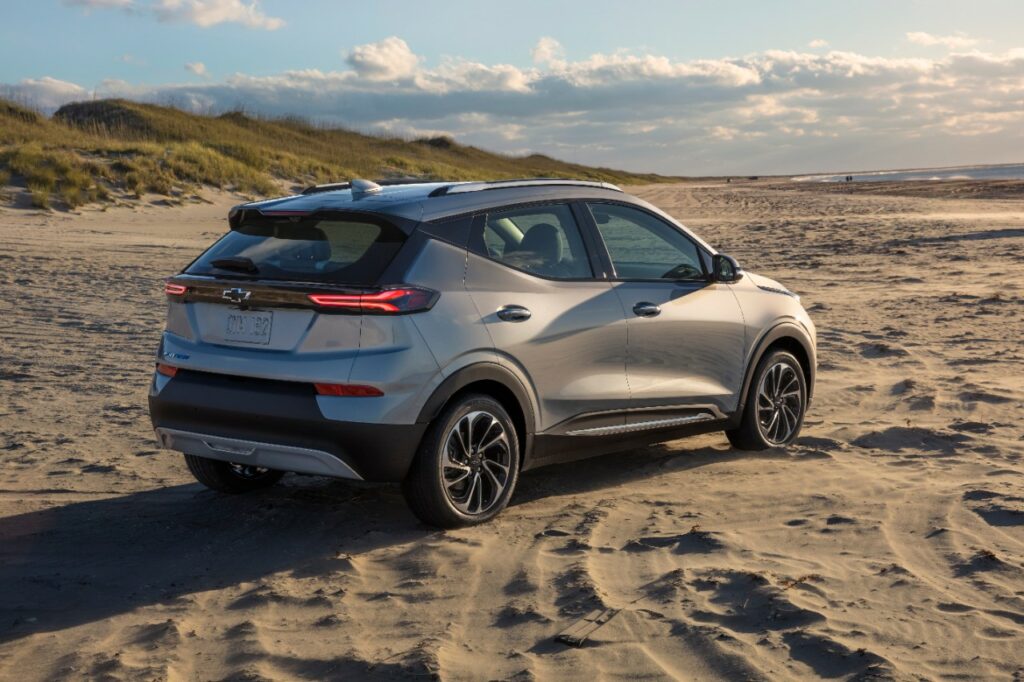
May 2022 Update: About half of 2017-2019 model year Bolts have received their recall fix, which includes a brand new battery pack. The new 2022 Bolt and Bolt EUV are back on sale at dealerships, complete with their new batteries.
The newly redesigned 2022 Chevrolet Bolt has a lot going for it: sleek new looks, modern tech, a new larger variant, and most of all, a starting MSRP of just $31,000. But as you probably know by now, GM’s golden opportunity went up in smoke when Bolts began to catch fire, sometimes burning down entire homes. Once a great budget EV, the Bolt has been ordered to socially distance by at least 50 feet from any building until GM works its way through the $2 billion dollar fix to get these cars back on the road safely.
There is a fix on the way, and it’s a fix that we’d like to think can’t go wrong. All Bolts from model years 2017 to 2019 are due to receive an all-new battery free of charge, and 2020-2022 models will receive. Could the Bolt fire disaster turn out to be a good thing for consumers in the end?
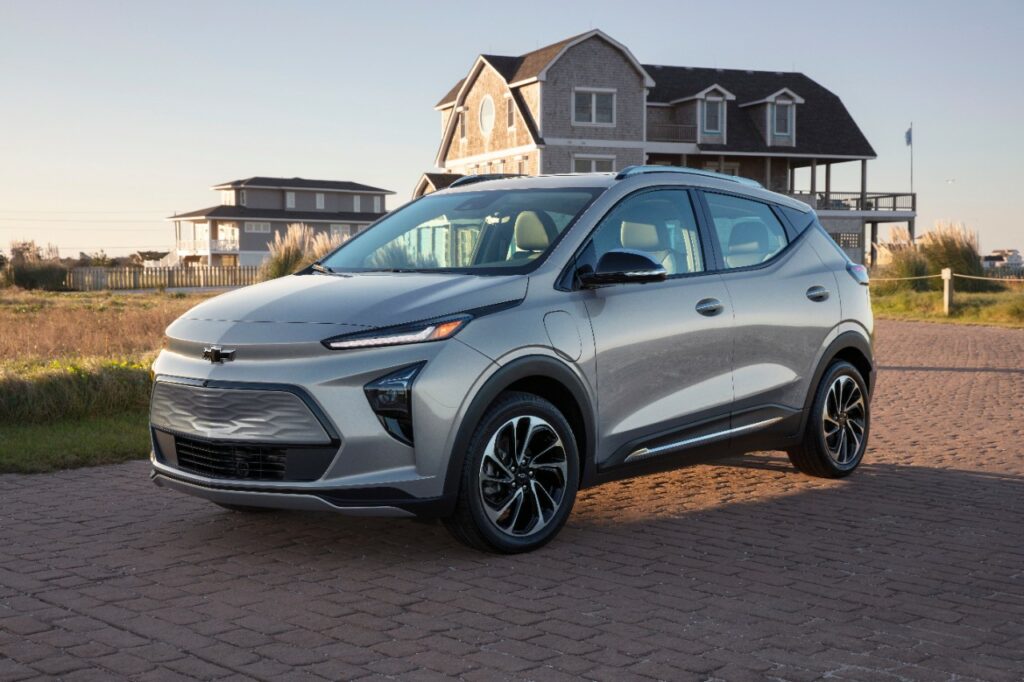
This is the Bolt’s first major refresh since it was unveiled in 2016. Back then, it harkened a new path for GM at a time when the future of electrified transportation was uncertain. Would EVs remain a luxury outlier for Tesla fans? Or would EVs end up appealing to the masses?
The 2017 Bolt arrived at dealerships to great fanfare, even going on to win both the North American Car of the Year and the Motor Trend Car of the Year awards in 2017. Following a few minor efficiency upgrades, by 2021 the Bolt was rated at 259 miles of range in the EPA test cycle. That’s a respectable figure even in today’s field of EVs. With the 2022 model year update came a shock to fans of affordable EVs: the 2022 Bolt had the same rated range, but it was listed for $5,500 less, new technology, curvy looks and all! It’s likely that the price drop was intended to reflect the loss of eligibility for the $7,500 federal tax credit.
Another unexpected announcement was the launch of the Bolt EUV, a larger sibling to the original compact Bolt. The new Bolt EUV is 6 inches longer with an extra 3 inches of backseat legroom. The EUV has a big tech advantage over the Bolt EV: it includes GM’s Super Cruise semi-autonomous driver assistance software. On paper, the 2022 Chevrolet Bolt EV and EUV looked like great deals. Even before the big refresh, efficiency, affordability and the former eligibility for the $7,500 federal tax credit lifted the Bolt to a spot in the top five in American EV sales for four years in a row.
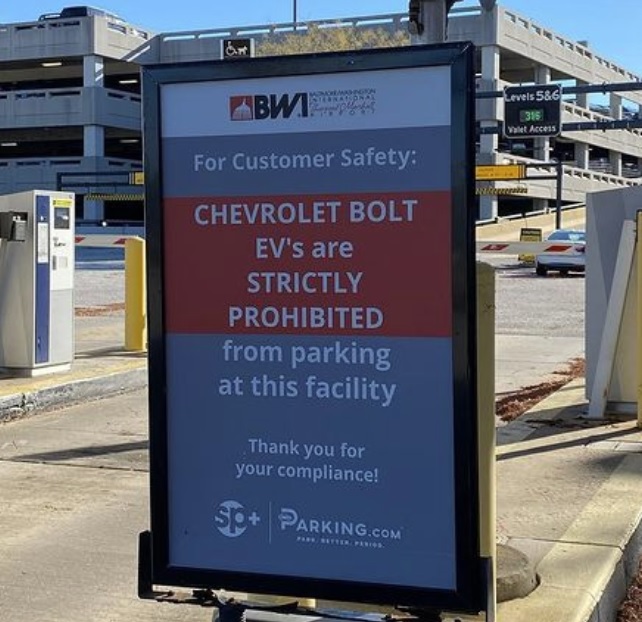
The Chevy Bolt has had its weaknesses since the beginning, but they were always manageable. A peak charging rate of 55kW that continues to this day was always the biggest inconvenience. But you get what you pay for, right? Well, no consumer should ever be cornered into an affordable vehicle that turns out to be a massive fire hazard and safety risk.
Beginning in 2017, news reports emerged of multiple Bolts catching fire in parking lots and driveways. Eventually, so many Bolts caught fire that GM issued a fix in late 2020, but it failed to solve the problem. By early 2021, the pattern was clear, and a combo recall and stop-sale were issued for all Bolts (2017-2022 model years). Production of 2022 Bolts was halted, and remains on pause through January.
We now know the root cause of the battery fires in certain Chevrolet Bolts, and it’s a defect that affects every model year in some capacity. A spokesperson for LG, the battery supplier for the Bolt, shared the cause with Consumer Reports. “GM and LG have identified the presence of two rare simultaneous defects, found in the same battery cell, made during the module manufacturing process.” GM explained that the cause is a torn anode tab and folded separator within the battery modules. What it comes down to is two very rare defects simultaneously occurring in the same battery cells.
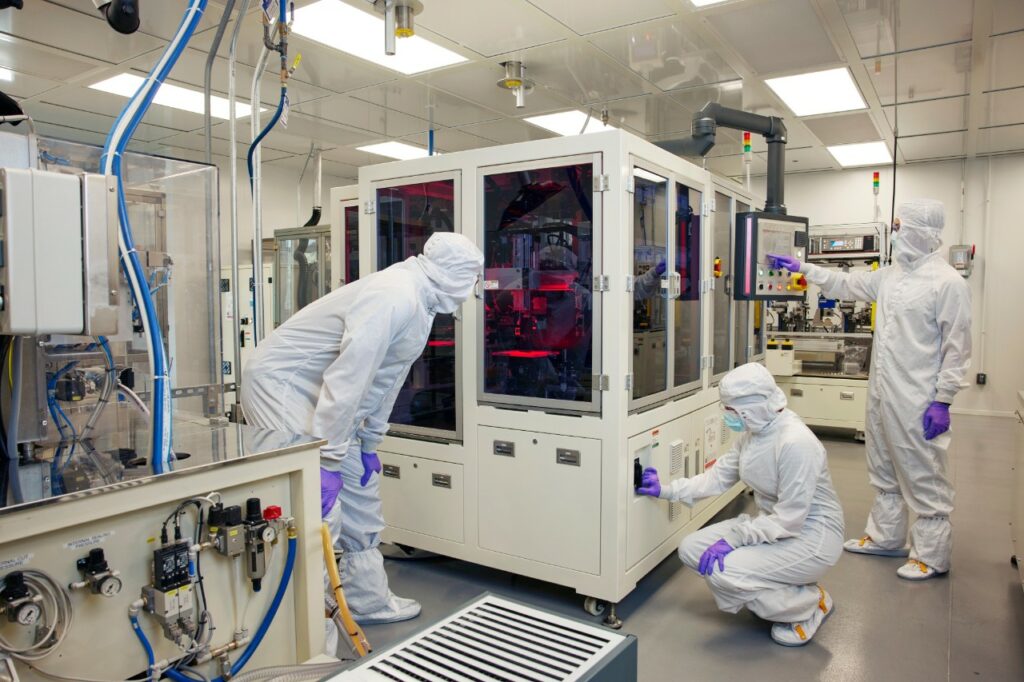
GM has to be furious with LG for supplying dangerous batteries to its car that was destined for mass appeal. There’s nothing appealing about buying a $30,000 fire hazard, not to mention the hassle of returning the vehicle for the recall. But it looks like the two behemoths have reached a deal. LG has agreed to compensate GM for the costs associated with the recall. When all is said and done (sometime in 2022), LG will be paying GM about $2 billion.
GM is going to replace all battery packs in 2017-2019 Bolts and will replace defective battery modules (partial replacement) in 2020-2022 Bolt EVs and EUVs. Repaired Bolts will come with a new eight-year, 100,000-mile limited warranty. GM will prioritize customers who have Bolts at the highest risk, but they’re not ready to release a timeline for completion, pending battery availabilty from the supplier. It’s looking like it may take a full year to complete the recall repairs.
As of December 2021, GM has started scheduling dealership visits to install a software upgrade for all eligible Bolts. The upgrade is “designed to detect specific abnormalities that might indicate a damaged battery in Bolt EVs and EUVs by monitoring the battery performance and alerting customers of any anomalies.” GM has not yet implemented over-the-air updates like Tesla, Ford and Volkswagen, so Bolt owners will have to visit a dealership to get the software fix.
Don’t rush out to buy a 2022 Bolt. There’s a stop-sale in effect, so you couldn’t buy one even if you tried. Considering the immense resources GM has thrown at this debacle, once all Bolts are fixed, it’s highly likely that the Bolt will return to its former glory as a true EV bargain worth checking out. The automaker’s engineers MUST have thoroughly investigated and fixed the problems, right? Unfortunately, due to LG’s battery production backlog, the Bolt probably won’t be worth considering until 2023.
Let’s time travel to 2023 together and forget about the battery recall for just a moment. The 2022 Chevrolet Bolt offers 259 miles of range, a modernized interior and refreshing exterior, all for a base MSRP of $31,000. In several states, the effective price of a 2022 Bolt can easily fall under $27,000, even though it no longer qualifies for the federal EV tax credit. If revisions to the EV tax credit ever make their way through congress, the Bolt might even become a $20k car. That’s a steal! proceed with caution and patience, and give GM and LG time to clean up their mess. Plus, there are dozens of other EVs arriving on American roads in 2022. The EV market is far different heading into 2022 than it was when the first generation Bolt arrived in 2016.
Even with the battery fixes, the Bolt still suffers from a poor charging rate of just 55 kW. If you roadtrip often, that will be an issue. Whereas the new 2022 Hyundai IONIQ 5 can recharge from 10-80% (over 200 miles of range) in just 18 minutes, the same charging session would take a full hour in a 2022 Bolt. If you’re on the market for a budget EV, the 2022 Chevrolet Bolt just might be worth a test drive, but not until GM wraps up the ongoing recall fixes. And that might take a whole year. Stay tuned to CarEdge for the latest EV information, car reviews and industry insights.
We have thousands of EVs (and other vehicles) listed today. Each listing includes industry insights, empowering data and the true TotalPrice that will make buying a car the transparent process it should’ve always been. Check it out here!
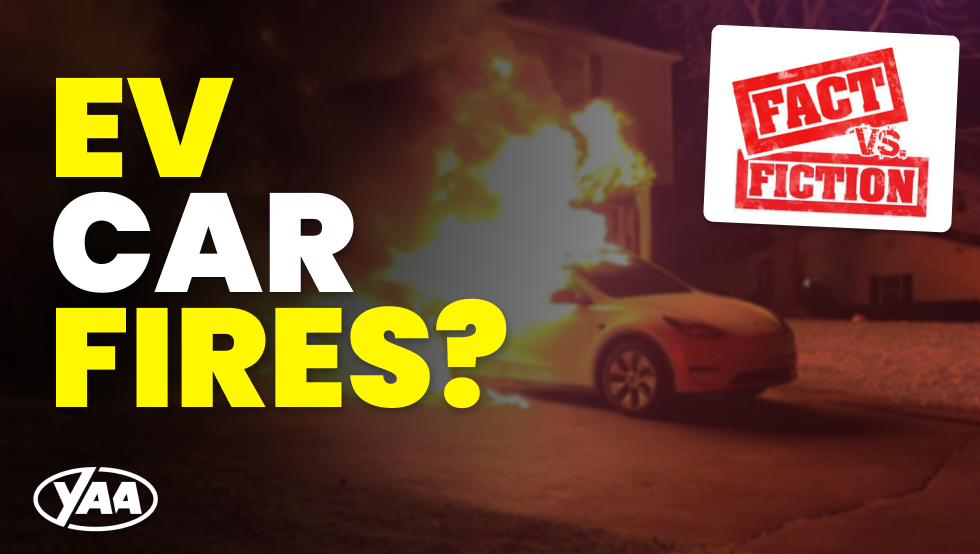
The Chevrolet Bolt’s recent fall from grace has had many EV-curious drivers wondering if EVs are even safe to drive. A quick look at US vehicular fire data makes it clear that car fires were a problem long before EVs (hey Ford Pinto!), but EVs do bring new challenges to automotive safety. Any material that can store enough energy to power a car, whether batteries or gasoline, is capable of volatility and potential safety hazards. However, a closer look at the statistics reveals surprising trends and comparisons. Will the dozens of EVs coming to market in 2022 face the same issues of older models? It’s important to get to the bottom of this. Your advocates at CarEdge will keep you informed with the latest information. Here’s what we know.

Data compiled by the National Fire protection Association (NFPA) and the US Department of Transportation shows that among all vehicle types, there’s an average of one vehicle fire per 19 million miles driven. Both the NFPA and the Center for Auto Safety say there is not yet a centralized database for electric vehicle fire statistics. In an effort to address the lack of information surrounding EV battery fires, Tesla decided to begin releasing statistics in their annual impact reports.
Tesla’s 2020 Impact Report says that from 2012-2020, there’s been one Tesla fire per 205 million miles traveled. The fact that Tesla models made up 79% of American EV sales in 2020 highlights the relevance of their data. Unfortunately, other automakers haven’t released comparable data (we’re looking at you GM!). We’re hopeful that will change soon.
This comparison doesn’t hide the fact that some EV models have had major problems. Most notably, the ongoing Chevrolet Bolt recall is costing GM and battery supplier LG a few billion dollars to resolve. The Hyundai Kona briefly made headlines with multiple fires. It seems like every Tesla fire makes it into the news. Henrik Fisker’s first shot at launching an automotive brand ended in tears when Hurricane Sandy flooded dozens of early Karma’s with saltwater, resulting in some setting ablaze. EV fires are real, and every one is serious and worthy of proper investigation.
An in-depth study of EV battery fires conducted by the NTSB found that most incidents are caused by a dangerous phenomenon known as thermal runaway. All modern electric vehicles have a thermal management system of some sort. Thermal management keeps the battery operating within the ideal range for performance and safety. Some thermal management systems use liquid coolants, others employ air or refrigerant coolants. But these systems are only designed to work during normal operating conditions. When a battery is punctured or contains manufacturing defects, a short circuit can occur when the anode and cathode come in contact. A shorted circuit can cause rapid thermal runaway. Simply put, if a damaged or defective battery malfunctions, it produces a lot of heat, and may result in a fire.

A spokesperson for LG, the battery supplier for the Bolt, shared the cause of the recent fires with Consumer Reports. “GM and LG have identified the presence of two rare simultaneous defects, found in the same battery cell, made during the module manufacturing process.” GM explained that the cause is a torn anode tab and folded separator within the batteries. What it comes down to is two very rare defects simultaneously occurring in the same battery cells.
As of December 2021, GM is just beginning the recall process. Owners of 2017-2019 Bolts will receive an all-new battery pack. Affected 2020-2022 cars will receive replacement batteries for the affected modules. Will the fix take care of the hazard once and for all? Considering the massive engineering effort that has gone into identifying the problem and proposing a solution, Chevy Bolts will likely have undergone even more safety checks than most cars are ever subjected to.
Anytime a Tesla goes up in flames, it’s sure to make the news. But how common are Tesla fires compared to combustion vehicle fires? Engineers (and nervous investors) have looked into every incident, and here is what they’ve found. GLJ Research analyst Gordon Johnson found reports of about 160 Tesla vehicle fires as of 2020, when there were 1 million Teslas on the road globally. That works out to about 0.01% of Teslas being involved in fire incidents, a figure that is less than most other OEMs.

The high publicity of Tesla’s isolated fire events prompted the automaker to address the topic directly in their own 2020 Impact Report. Tesla says there has been approximately one Tesla vehicle fire for every 205 million miles traveled. The report goes on to point out that analyses of combustion-powered vehicle fires conducted by the National Fire protection Association (NFPA) and U.S. Department of Transportation shows one fire for every 19 million miles travelled. As Elon Musk once spouted on his infamous Twitter account, “Not super surprising, given that internal combustion engine cars literally have ‘combustion’ in their name.”
Perhaps one reason Tesla has avoided the major recalls that the Chevy Bolt, Hyundai Kona and some hybrids have faced is the fact that Tesla regularly pushes over-the-air updates to all of their cars. If a thermal management issue is ever discovered by their engineers, for example, it would most likely be solved with a quick software update. Most automakers have yet to implement OTA updates at this level of precision, but Ford, Volkswagen and even GM are coming around to the idea.
Although the data clearly shows that EVs are less prone to car fires than combustion vehicles, there are major safety concerns for the firefighters who extinguish the flames when an EV fire does occur. Firefighters need special training to learn how to safely approach EV-related incidents, but only two-thirds of departments have had the opportunity due to funding constraints.
EV battery fires require A LOT more water to extinguish. Tesla’s First Responders Guide recommends 3,000 to 8,000 gallons of water on hand to put out a Tesla fire. Some fires have needed 30,000 gallons of water to extinguish. Basically, firefighters have to do whatever it takes to cool down the battery, and that’s really hard to do with so much energy densely packed into the pack. Once the fire appears fully extinguished, there’s a chance it could still flare up, even days later. Towing services and junkyards are advised to park damaged electric vehicles at least 50 feet from other vehicles in the yard. As EVs become more popular, that might not be feasible in just a few years.
The National Transportation Safety Board’s (NTSB) review of emergency response guidelines from 36 EV manufacturers found that all had ways to mitigate the risk of high-voltage shocks, but none of the guides addressed how to reduce the risk posed by energy stored in the batteries, such as procedures for minimizing reignition or instructions on where and how to spray water to cool the batteries. Clearly, EV automakers have some serious work to do for the safety of first responders.

Although EV battery fires are still infrequent compared to traditional vehicles, there are still ways to make EVs safer. Solid state batteries are nearly ready for mass production. They promise to revolutionize the automotive industry with extreme efficiency, affordability and incredible duration. The solid electrolyte that lies within is less volatile than the liquid electrolytes used in today’s lithium ion batteries. Solid Power, a leading solid state battery developer, has conducted third-party testing to examine the safety of solid state batteries when they’re exposed to stressors such as puncture or short-circuiting. No fires occurred at all during laboratory testing, only voltage loss.
Over-the-air updates will soon be a feature (or add-on) of most vehicles on the market. OTA updates present an opportunity for automakers to address future battery safety concerns without even needing to issue a full recall. Tesla’s leadership in OTA updates set an example that legacy OEMs are following.
Early on during the rise of EVs (2012-2017), batteries had never before been produced at such high volumes. New manufacturing techniques were needed, and assembly lines had to flush out the usual inefficiencies that affect any new manufacturing process at scale. Now that EV production is maturing and battery suppliers have been at it for a decade or more, engineers, chemists and industrial designers are well-versed in the best practices of making batteries that are both cost effective and safe. Just like with refining and transporting petroleum products, battery production can go wrong if safety and sound engineering aren’t top of mind.
More data is needed, but Tesla’s 2020 Impact Report provides the best look yet at how common EV battery fires are in comparison to non-electric vehicles. Tesla EVs make up 79% of American EV sales, so their data are somewhat representative of the EV market as a whole. The statistics suggest that Teslas are far less prone to fire than combustion vehicles, which is a very different story than one would gather from watching the news. However, Tesla’s overall reliability ratings remain low, which is concerning in its own right.
What about other EV makers? With popular models like the Ford Mustang Mach-E, Volkswagen ID.4 and Hyundai IONIQ 5 hitting the roads this year, we should have more data soon. Every publicized EV fire damages consumer sentiment about the shift to electrification. Surely, automakers investing over $300 billion in EVs would throw everything they’ve got at fixing safety hazards and ensuring that EVs are the safest cars on the road. At CarEdge, we’ll continue to monitor the latest and we’ll bring you any updates as EVs go mainstream in 2022.
We have thousands of EVs (and other vehicles) listed today. Each listing includes industry insights, empowering data and the true TotalPrice that will make buying a car the transparent process it should’ve always been. Check it out here!